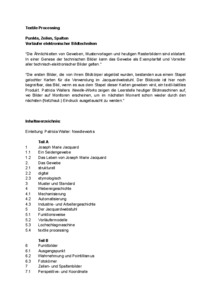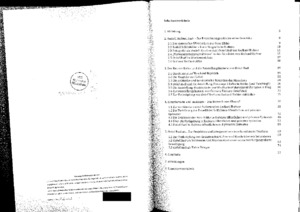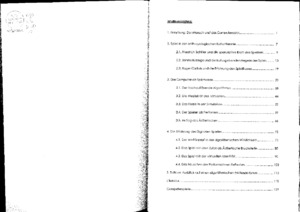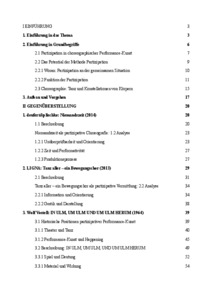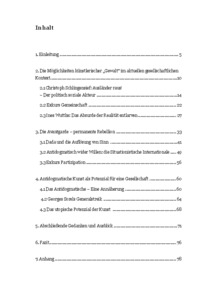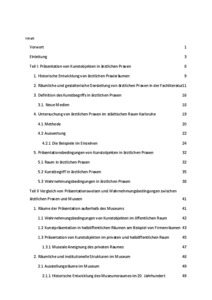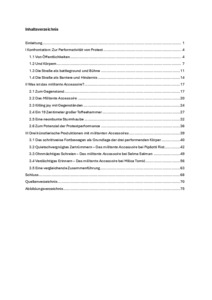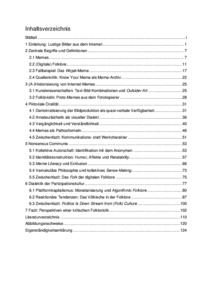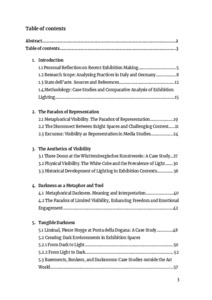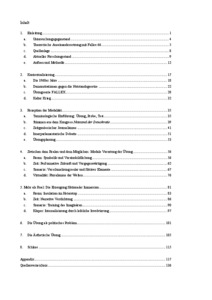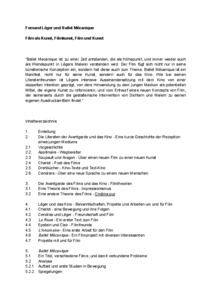"Inhaltsverzeichnis"
| Begriff | Inhaltsverzeichnis |
| Metakey | Beziehung/Funktion (media_object:relationship) |
| Typ | Keyword |
| Vokabular | Medienobjekt |
18 Inhalte
- Seite 1 von 2
Textile Processing
- Titel
- Textile Processing
- Untertitel
- Punkte, Zeilen, Spalten; Vorläufer elektronischer Bildtechniken
- Autor/in
- Beschreibung (de)
- „Die Ähnlichkeiten von Geweben, Mustervorlagen und heutigen Rasterbildern sind eklatant. In einer Genese der technischen Bilder kann das Gewebe als Exemplarfall und Vorreiter aller technisch-elektronischer Bilder gelten.”
„Die ersten Bilder, die von ihrem Bildkörper abgelöst wurden, bestanden aus einem Stapel gelochter Karten für die Verwendung im Jacquardwebstuhl. Der Bildcode ist hier noch begreifbar, das Bild, wenn es aus dem Stapel dieser Karten gewoben wird, ein textil-taktiles Produkt. Patricia Wallers Needle-Works zeigen die Leerstelle heutiger Bildmaschinen auf, wo Bilder auf Monitoren erscheinen, um im nächsten Moment schon wieder durch den nächsten (Netzhaut-) Eindruck ausgetauscht zu werden.”
- „Die Ähnlichkeiten von Geweben, Mustervorlagen und heutigen Rasterbildern sind eklatant. In einer Genese der technischen Bilder kann das Gewebe als Exemplarfall und Vorreiter aller technisch-elektronischer Bilder gelten.”
- Beschreibung (en)
- “The similarities between fabrics, patterns and today's raster images are striking. In the genesis of technical images, the fabric can be regarded as an exemplary case and forerunner of all technical-electronic images.”
“The first images that were detached from their image body consisted of a stack of perforated cards for use in the Jacquard loom. The image code is still comprehensible here, the image, when woven from the pile of these cards, is a textile-tactile product. Patricia Waller's needle works show the blank space of today's image machines, where images appear on monitors only to be replaced by the next (retinal) impression in the very next moment.”
- “The similarities between fabrics, patterns and today's raster images are striking. In the genesis of technical images, the fabric can be regarded as an exemplary case and forerunner of all technical-electronic images.”
- Kategorie
- Typ des Projekts/Werks
- Schlagworte
- Datierung
- 02.11.1998
- Sprache
- Ort: Institution
- Stadt
- Titel
- Textile Processing
- Urheberrechtshinweis
- Brigit Schneider
- Rechtsschutz/Lizenz
- Freigabe Nutzung HfG
- Medienersteller/in
- Beziehung/Funktion
- Projektleiter/in
- Semester
- Studiengang
- Typ der Abschlussarbeit
- Archiv-Signatur
- HfG HS 1998 02
- Externes Archiv
- Importiert am
- 04.08.2023
- Übergeordnete Sets
- 1
Onkel Rudi als... (Inhaltsverzeichnis)
- Titel
- Onkel Rudi als... (Inhaltsverzeichnis)
- Untertitel
- zur Werk- und Wirkungsgeschichte eines Gemäldes von Gerhard Richter im Spiegel seiner Selbstäußerungen
- Autor/in
- Beschreibung (de)
- „Das Jahr 2012 stand ganz im Zeichen Gerhard Richters. So konnte man ihm im Kino bei der Arbeit bei der Arbeit über die Schulter schauen – so der bereits erstmals im September 2011 präsentierte Kinofilm Painting von Corinna Belz .., was einherging mit dem beachtlichen Erfolg auf dem secondary market, dem Auktionsmarkt, wo seine vornehmlich abstrakten Gemälde dank Höchstpreisen zu Kunstmarktlieblingen avancierten.”
„Gerade ein Gemälde scheint anders als viele andere in den letzten Jahren immer mehr mit symbolischer Bedeutung aufgeladen worden zu sein: Onkel Rudi (Abb.1), entstanden 1965. Die fotografische Vorlage entnahm Richter dem eigenen Familienalbum. Als ‚Privates öffentlich’ machen, wurde diese Vorgehensweise in der Motivauswahl der so genannten Foto-Bilder vielfach begründet. Dies zeigt sich nicht zuletzt in den Fotografien, die Richter auf Einladung der Tageszeitung „Die Welt” für eine Sonderausgabe ausdrucken ließ – und damit ist “der große Zweifler der Gegenwartskunst” erst der dritte Künstler, nach Georg Baselitz und Ellsworth Kelly, die die „Welt-Herrschaft” für einen Tag übernommen hat.”
- „Das Jahr 2012 stand ganz im Zeichen Gerhard Richters. So konnte man ihm im Kino bei der Arbeit bei der Arbeit über die Schulter schauen – so der bereits erstmals im September 2011 präsentierte Kinofilm Painting von Corinna Belz .., was einherging mit dem beachtlichen Erfolg auf dem secondary market, dem Auktionsmarkt, wo seine vornehmlich abstrakten Gemälde dank Höchstpreisen zu Kunstmarktlieblingen avancierten.”
- Beschreibung (en)
- "The year 2012 was all about Gerhard Richter. It was possible to watch him at work in the cinema - for example, the cinema film Painting by Corinna Belz, first presented in September 2011 ... which was accompanied by considerable success on the secondary market, the auction market, where his predominantly abstract paintings became art market favourites thanks to top prices.‘
’One painting in particular, unlike many others, seems to have been increasingly charged with symbolic meaning in recent years: Uncle Rudi (fig. 1), created in 1965. Richter took the photographic model from his own family album. This approach was often justified as “publicising the private” in the choice of motifs for the so-called photo images. This can be seen not least in the photographs that Richter had printed for a special edition at the invitation of the daily newspaper ‘Die Welt’ - making ‘the great doubter of contemporary art’ only the third artist, after Georg Baselitz and Ellsworth Kelly, to take over ‘Welt/world domination’ for a day."
- "The year 2012 was all about Gerhard Richter. It was possible to watch him at work in the cinema - for example, the cinema film Painting by Corinna Belz, first presented in September 2011 ... which was accompanied by considerable success on the secondary market, the auction market, where his predominantly abstract paintings became art market favourites thanks to top prices.‘
- Kategorie
- Typ des Projekts/Werks
- Schlagworte
- Datierung
- 15.01.2013
- Sprache
- Ort: Institution
- Titel
- Onkel Rudi als... (Inhaltsverzeichnis)
- Urheberrechtshinweis
- Hendrik Bündge
- Rechtsschutz/Lizenz
- Freigabe Nutzung HfG
- Medienersteller/in
- Beziehung/Funktion
- Projektleiter/in
- Semester
- Studiengang
- Typ der Abschlussarbeit
- Archiv-Signatur
- HfG HS 2013 01
- Externes Archiv
- Importiert am
- 17.03.2025
- Übergeordnete Sets
- 1
Die Erfahrung des digitalen Spiels Inhaltsverzeichnis
- Titel
- Die Erfahrung des digitalen Spiels Inhaltsverzeichnis
- Untertitel
- Eine Philosophie des algrotithmischen Mediums
- Autor/in
- Beschreibung (de)
- „Jede Generation hat ein eigenen Zugang zu der ästhetischen Erfahrung, und für die des 21. Jahrhunderts stellt das Computerspiel ein zentrales Initiationsmedium hierzu dar. Es scheint sich im allgemeinen Bewusstsein mehr und mehr die Überzeugung durchzusetzen, dass Computerspiele als Leitmedium des 21. Jahrhunderts die Rolle des Films und des Kinos als Leitmedien des 20. Jahrhunderts übernehmen. Nicht nur sind historisch betrachtet Videospiele als Vorläufer der Medienkunst zu verstehen, sie stellen auch als zeitgenössische Phänomen zentrale Errungenschaften der Medienkunst in Form eines Massenmedium dar.”
„Das Internet hat uns gelehrt, dass wir in Systemen leben, in welchen wir arbeiten und lernen. Spiele basieren auf Systemen und in einem Spiel sich zu bewegen bedeutet, sich im System zu bewegen. In einer Zeit, in der das komplexe Funktionieren von ineinander greifenden Systemen nicht mehr durch eindimensionale Denkleistung begriffen werden kann, bieten die medialen Künste ein Denk- und Handlungsmodell an, dass nicht nur von Repräsentationen und direkten Bezügen geleitet wird, sondern ein größere Sensibilität gegenüber komplexeren Parametern und Variabilitäten anbietet.”
- „Jede Generation hat ein eigenen Zugang zu der ästhetischen Erfahrung, und für die des 21. Jahrhunderts stellt das Computerspiel ein zentrales Initiationsmedium hierzu dar. Es scheint sich im allgemeinen Bewusstsein mehr und mehr die Überzeugung durchzusetzen, dass Computerspiele als Leitmedium des 21. Jahrhunderts die Rolle des Films und des Kinos als Leitmedien des 20. Jahrhunderts übernehmen. Nicht nur sind historisch betrachtet Videospiele als Vorläufer der Medienkunst zu verstehen, sie stellen auch als zeitgenössische Phänomen zentrale Errungenschaften der Medienkunst in Form eines Massenmedium dar.”
- Beschreibung (en)
- "Every generation has its own approach to the aesthetic experience and for those of the 21st century, the computer game represents a central initiation medium for this. There seems to be a growing conviction in the general consciousness that computer games, as the leading medium of the 21st century, are taking over the role of film and cinema as the leading media of the 20th century. Not only can video games be seen historically as precursors of media art, they also represent central achievements of media art in the form of a mass medium as a contemporary phenomenon.
"The Internet has taught us that we live in systems in which we work and learn. Games are based on systems and to move in a game means to move in the system. At a time when the complex functioning of interlocking systems can no longer be understood through one-dimensional thinking, the media arts offer a model of thought and action that is not only guided by representations and direct references, but offers a greater sensitivity to more complex parameters and variabilities."
- "Every generation has its own approach to the aesthetic experience and for those of the 21st century, the computer game represents a central initiation medium for this. There seems to be a growing conviction in the general consciousness that computer games, as the leading medium of the 21st century, are taking over the role of film and cinema as the leading media of the 20th century. Not only can video games be seen historically as precursors of media art, they also represent central achievements of media art in the form of a mass medium as a contemporary phenomenon.
- Kategorie
- Schlagworte
- Datierung
- 06.07.2010
- Sprache
- Ort: Institution
- Titel
- Die Erfahrung des digitalen Spiels Inhaltsverzeichnis
- Urheberrechtshinweis
- Adam Rafinksi
- Rechtsschutz/Lizenz
- Freigabe Nutzung HfG
- Medienersteller/in
- Beziehung/Funktion
- Projektleiter/in
- Studiengang
- Typ der Abschlussarbeit
- Archiv-Signatur
- HfG HS 2010 07
- Externes Archiv
- Importiert am
- 20.02.2025
- Übergeordnete Sets
- 1
Teilnahme in Bewegung Inhaltsverzeichnis
- Titel
- Teilnahme in Bewegung Inhaltsverzeichnis
- Untertitel
- die Funktion der Partizipation des Publikums in choreografischer Performance-Kunst
- Autor/in
- Beschreibung (de)
- „Die Partizipation des Publikums in Performance-Kunst – der Titel der Magisterarbeit – ruft die Vorstellung eines klassischen ,Mitmach‘-Theaters beziehungsweise eines von ,mitmachenden‘ Performance-BesucherInnen hervor, in dem das Publikum dazu angehalten wird, sich aktiv und produktiv am Geschehen der Aufführung zu beteiligen. Auch am Beginn meiner Recherche stand diese Vorstellung und Partizipation damit als Phänomen, dem – sowohl von der Seite der RezipientInnen aus, als auch von der der PerformerInnen und der KünstlerInnen – zum einen mit großen Unbehagen, zum anderen mit großer Begeisterung begegnet wird.”
„Das Versprechen, das von der Partizipation des Publikums ausgeht, baut darauf, der konventionell passiven und kontemplativen Betrachtung des Kunstwerks, das von einer singulären Autorschaft gefertigt wurde, entgegenzuwirken. Das Unbehagen gegenüber Partizipation drückt sich zum einen in der Skepsis aus, ob Partizipation die Funktion der Aktivierung des Publikums leisten kann. Bedeutet Teilhabe nicht, dass das Publikum innerhalb eines festgelegten Rahmens und eines bestehenden Konzeptes bloß mitmachen ,darf‘? Heißt das nicht, dass es noch immer in passiver Unmündigkeit gefangen bleibt, aber nun, ja noch schlimmer, mit der Illusion der eigenen Souveränität? In der folgenden Analyse werde ich zeigen, dass die Bezeichnungen aktiv und passiv, selbstbestimmt und determiniert und die damit einhergehenden normativen Befunde allerdings genauerer Differenzierung bedürfen.”
- „Die Partizipation des Publikums in Performance-Kunst – der Titel der Magisterarbeit – ruft die Vorstellung eines klassischen ,Mitmach‘-Theaters beziehungsweise eines von ,mitmachenden‘ Performance-BesucherInnen hervor, in dem das Publikum dazu angehalten wird, sich aktiv und produktiv am Geschehen der Aufführung zu beteiligen. Auch am Beginn meiner Recherche stand diese Vorstellung und Partizipation damit als Phänomen, dem – sowohl von der Seite der RezipientInnen aus, als auch von der der PerformerInnen und der KünstlerInnen – zum einen mit großen Unbehagen, zum anderen mit großer Begeisterung begegnet wird.”
- Beschreibung (en)
- ‘The participation of the audience in performance art - the title of the master's thesis - evokes the idea of a classic ‘participatory’ theatre or one of ‘participating’ performance visitors, in which the audience is encouraged to actively and productively participate in the events of the performance. At the beginning of my research, this idea and participation was also a phenomenon that was met with great discomfort on the one hand and great enthusiasm on the other, both on the part of the recipients and the performers and artists.’
‘The promise of audience participation is based on counteracting the conventionally passive and contemplative view of the artwork produced by a singular authorship. The unease about participation is expressed on the one hand in the scepticism as to whether participation can fulfil the function of activating the audience. Doesn't participation mean that the audience is merely ‘allowed’ to take part within a fixed framework and an existing concept? Does this not mean that they are still trapped in passive immaturity, but now, even worse, with the illusion of their own sovereignty? In the following analysis, I will show that the terms active and passive, self-determined and determined and the associated normative findings require more precise differentiation.’
- ‘The participation of the audience in performance art - the title of the master's thesis - evokes the idea of a classic ‘participatory’ theatre or one of ‘participating’ performance visitors, in which the audience is encouraged to actively and productively participate in the events of the performance. At the beginning of my research, this idea and participation was also a phenomenon that was met with great discomfort on the one hand and great enthusiasm on the other, both on the part of the recipients and the performers and artists.’
- Kategorie
- Typ des Projekts/Werks
- Schlagworte
- Sprache
- Ort: Institution
- Titel
- Teilnahme in Bewegung Inhaltsverzeichnis
- Urheberrechtshinweis
- © Mira Hirtz
- Rechtsschutz/Lizenz
- Freigabe Nutzung HfG
- Medienersteller/in
- Beziehung/Funktion
- Projektleiter/in
- Semester
- Studiengang
- Typ der Abschlussarbeit
- Archiv-Signatur
- HfG HS 2015 05
- Externes Archiv
- Importiert am
- 30.03.2025
- Übergeordnete Sets
- 1
Bildstrategien: Inhaltsverzeichnis
- Titel
- Bildstrategien: Inhaltsverzeichnis
- Autor/in
- Beschreibung (de)
- „Rudolf Herz hat mit seiner Ausstellung im Fotomuseum im Münchner Stadtmuseum und der gleichnamigen Publikation „Hoffmann und Hitler – Fotografie als Medium des Führer-Mythos“ 1994 einen wichtigen Grundstein für die Forschung um Heinrich Hoffmann, Adolf Hitler und die fotografische Führerpropaganda gelegt. Herz führt in seiner Darlegung in gewisser Weise eine Genealogie des „Hitlerbildes“ aus, das durch die Fotografie Hoffmanns seinen Ausdruck fand: Beginnend mit frühen fotografischen Portraitstudien, die von Heinrich Hoffmann als Postkarten vertrieben wurden, eröffnet der Medienforscher Herz in seinem Buch ein Panorama, das nicht nur die Herausformung der Figur Hitler zeigt, sondern auch die darauf folgenden Bildgattungen, in denen Hitler als Mensch vermarktet wurde.”
„Dieser Band ist nicht der erste Versuch, Adolf Hitler als Bildkonstante in die Gesellschaft einzuführen. Allerdings ist es der erste erfolgreiche Bildband, der es schafft, nicht nur von Hitler zu erzählen, sondern ihn mittels geschickt arrangierter Bildfolge zugleich als Führer und als natürlichen Menschen erscheinen zu lassen. In welchem Zeitraum des Jahres 1932 genau der Bildband „Hitler wie ihn keiner kennt“ erschienen ist, kann mittels der heute noch vorliegenden Bände nicht mehr rekonstruiert werden. Es ist vor allem der Rückgriff auf den Kontext, der in der analytischen Betrachtung und Einordnung des Bandes helfen muss. Das Medium Fotografie wird hier ein zweites Mal wirksam, jedoch nicht immanent (narrativ), sondern aus historischer Perspektive: eine Perspektive, die an dieser Stelle trotz propagandistischer Bildkonzeption auch dokumentarisch Auskunft geben kann.”
- „Rudolf Herz hat mit seiner Ausstellung im Fotomuseum im Münchner Stadtmuseum und der gleichnamigen Publikation „Hoffmann und Hitler – Fotografie als Medium des Führer-Mythos“ 1994 einen wichtigen Grundstein für die Forschung um Heinrich Hoffmann, Adolf Hitler und die fotografische Führerpropaganda gelegt. Herz führt in seiner Darlegung in gewisser Weise eine Genealogie des „Hitlerbildes“ aus, das durch die Fotografie Hoffmanns seinen Ausdruck fand: Beginnend mit frühen fotografischen Portraitstudien, die von Heinrich Hoffmann als Postkarten vertrieben wurden, eröffnet der Medienforscher Herz in seinem Buch ein Panorama, das nicht nur die Herausformung der Figur Hitler zeigt, sondern auch die darauf folgenden Bildgattungen, in denen Hitler als Mensch vermarktet wurde.”
- Beschreibung (en)
- ‘With his exhibition at the Fotomuseum in Munich's Stadtmuseum and the publication of the same name ‘Hoffmann and Hitler - Photography as a Medium of the Führer Myth’ in 1994, Rudolf Herz laid an important foundation stone for research into Heinrich Hoffmann, Adolf Hitler and photographic Führer propaganda. In his account, Herz sets out a kind of genealogy of the ‘Hitler image’, which found its expression through Hoffmann's photography: Beginning with early photographic portrait studies that were distributed by Heinrich Hoffmann as postcards, media researcher Herz opens up a panorama in his book that shows not only the moulding of the figure of Hitler, but also the subsequent image genres in which Hitler was marketed as a human being.’
‘This volume is not the first attempt to introduce Adolf Hitler into society as an image constant. However, it is the first successful illustrated book that manages not only to tell the story of Hitler, but also to make him appear both as a leader and as a natural human being by means of a skilfully arranged sequence of images. It is no longer possible to reconstruct exactly when the illustrated book ‘Hitler wie ihn keiner kennt’ was published in 1932 using the volumes still available today. It is above all the recourse to the context that must help in the analytical consideration and categorisation of the volume. The medium of photography becomes effective a second time here, but not immanently (narratively), but from a historical perspective: a perspective that can also provide documentary information at this point, despite the propagandistic image concept.’
- ‘With his exhibition at the Fotomuseum in Munich's Stadtmuseum and the publication of the same name ‘Hoffmann and Hitler - Photography as a Medium of the Führer Myth’ in 1994, Rudolf Herz laid an important foundation stone for research into Heinrich Hoffmann, Adolf Hitler and photographic Führer propaganda. In his account, Herz sets out a kind of genealogy of the ‘Hitler image’, which found its expression through Hoffmann's photography: Beginning with early photographic portrait studies that were distributed by Heinrich Hoffmann as postcards, media researcher Herz opens up a panorama in his book that shows not only the moulding of the figure of Hitler, but also the subsequent image genres in which Hitler was marketed as a human being.’
- Kategorie
- Schlagworte
- Datierung
- 01.03.2011
- Sprache
- Ort: Institution
- Titel
- Bildstrategien: Inhaltsverzeichnis
- Urheberrechtshinweis
- © Christina Irrgang
- Rechtsschutz/Lizenz
- Freigabe Nutzung HfG
- Medienersteller/in
- Beziehung/Funktion
- Projektleiter/in
- Semester
- Studiengang
- Typ der Abschlussarbeit
- Archiv-Signatur
- HfG HS 2011 04
- Externes Archiv
- Importiert am
- 31.03.2025
- Übergeordnete Sets
- 1
Konstruktive Unterbrechungen Inhaltsverzeichnis
- Titel
- Konstruktive Unterbrechungen Inhaltsverzeichnis
- Untertitel
- antidogmatische Kunst als gesellschaftliches Potenzial
- Autor/in
- Beschreibung (de)
- „Immer wieder beschäftigten sich in den letzten Jahren Ausstellungen mit explizit politischer Kunst. Kunst, politische Kunst, künstlerischer Aktivismus und politischer Aktivismus entwickelten sich in der Warnehmung der BetrachterInnen zu einem Knoten, dessen künstlerische Wirkmacht im formalen institutionellen Rahmen auf der Strecke blieb.”
„Dort, wo Altes durch Neues herausgefordert wird. Dort, wo Kunst und Theater auf das alltägliche und das politische Leben treffen. Nicht umsonst forderten Künstler wiederholt die Annäherung von Kunst und Leben. Denn dort, wo beides aufeinander prallt, findet Auseinandersetzung statt. Dabei ist es nicht wichtig, was Kunst genau ist und wo sie anfängt oder aufhört. Relevant ist, dass Brüche geschaffen werden im reibungslosen Ablauf eines problematischen Systems. Es geht um eine Fraktur der Erwartung, um eine Unterbrechung des Gewohnten. Diese Strategie der Unterbrechung ist interessant für die vorliegende Arbeit.”
- „Immer wieder beschäftigten sich in den letzten Jahren Ausstellungen mit explizit politischer Kunst. Kunst, politische Kunst, künstlerischer Aktivismus und politischer Aktivismus entwickelten sich in der Warnehmung der BetrachterInnen zu einem Knoten, dessen künstlerische Wirkmacht im formalen institutionellen Rahmen auf der Strecke blieb.”
- Beschreibung (en)
- ‘In recent years, exhibitions have repeatedly focussed on explicitly political art. In the perception of viewers, art, political art, artistic activism and political activism have developed into a knot whose artistic impact has fallen by the wayside within the formal institutional framework.’
‘Where the old is challenged by the new. Where art and theatre meet everyday and political life. It is not for nothing that artists have repeatedly called for the convergence of art and life. Because where the two collide, confrontation takes place. It is not important what exactly art is and where it begins or ends. What is relevant is that breaks are created in the smooth running of a problematic system. It is about a fracture of expectation, an interruption of the familiar. This strategy of interruption is interesting for the present work.’
- ‘In recent years, exhibitions have repeatedly focussed on explicitly political art. In the perception of viewers, art, political art, artistic activism and political activism have developed into a knot whose artistic impact has fallen by the wayside within the formal institutional framework.’
- Kategorie
- Typ des Projekts/Werks
- Schlagworte
- Datierung
- 10.07.2014
- Sprache
- Ort: Institution
- Titel
- Konstruktive Unterbrechungen Inhaltsverzeichnis
- Urheberrechtshinweis
- © Seraphine Meya
- Rechtsschutz/Lizenz
- Freigabe Nutzung HfG
- Medienersteller/in
- Beziehung/Funktion
- Projektleiter/in
- Semester
- Studiengang
- Typ der Abschlussarbeit
- Archiv-Signatur
- HfG HS 2014 01
- Externes Archiv
- Importiert am
- 30.03.2025
- Übergeordnete Sets
- 1
Kunst in der Praxis - Inhaltsverzeichnis
- Titel
- Kunst in der Praxis - Inhaltsverzeichnis
- Autor/in
- Titel
- Kunst in der Praxis - Inhaltsverzeichnis
- Urheberrechtshinweis
- © Hanna Jurisch
- Rechtsschutz/Lizenz
- Freigabe Nutzung HfG
- Medienersteller/in
- Beziehung/Funktion
- Projektleiter/in
- Studiengang
- Typ der Abschlussarbeit
- Importiert am
- 13.10.2025
- Übergeordnete Sets
- 1
Inhaltsverzeichnis
- Titel
- Inhaltsverzeichnis
- Autor/in
- Titel
- Inhaltsverzeichnis
- Urheberrechtshinweis
- © Josefine Scheu
- Rechtsschutz/Lizenz
- Freigabe Nutzung HfG
- Medienersteller/in
- Beziehung/Funktion
- Projektleiter/in
- Semester
- Studiengang
- Typ der Abschlussarbeit
- Importiert am
- 21.06.2025
- Übergeordnete Sets
- 1
By Users for Users. Inhaltsverzeichnis
- Titel
- By Users for Users. Inhaltsverzeichnis
- Datierung
- 05.02.2025
- Titel
- By Users for Users. Inhaltsverzeichnis
- Titel (en)
- By Users for Users. Table of Contents
- Urheberrechtshinweis
- © Moritz Konrad
- Rechtsschutz/Lizenz
- Medienersteller/in
- Beziehung/Funktion
- Projektleiter/in
- Semester
- Studiengang
- Typ der Abschlussarbeit
- Importiert am
- 08.07.2025
- Übergeordnete Sets
- 1
Shadows of Reflection: Rethinking Museum (spaces) through Darkness. Table of contents.
- Titel
- Shadows of Reflection: Rethinking Museum (spaces) through Darkness. Table of contents.
- Titel
- Shadows of Reflection: Rethinking Museum (spaces) through Darkness. Table of contents.
- Urheberrechtshinweis
- © Livia Emma Lazzarini
- Freigabe Nutzung HfG
- Medienersteller/in
- Beziehung/Funktion
- Medien-Beschreibung (en)
- Dissertation Table of contents
- Importiert am
- 24.06.2025
- Übergeordnete Sets
- 1
Die Übung eines gesellschaftlichen Imaginären Inhaltsverzeichnis
- Titel
- Die Übung eines gesellschaftlichen Imaginären Inhaltsverzeichnis
- Untertitel
- Eine Untersuchung der Beteiligung der deutschen Bundesregierung an dem NATO-Manöver Fallex 66 (1966) hinsichtlich ihrer Modalität, Fiktionalität und Immersivität.
- Autor/in
- Beschreibung (de)
- „Fallex 66 war die dritte von zwölf biennalen Stabsrahmenübungen, die zwischen 1962 und 1982 durch die NATO organisiert wurden. Während des Kalten Krieges fanden Übungsmanöver regelmäßig statt, um mit bedingter Truppenbewegung Prozesse der Mobilisierung zu simulieren, Alarm- und Evakuierungspläne zu testen, aber auch um
Souveränität zu demonstrieren. Als solche waren sie wichtiger Teil der damaligen Abschreckungsstrategie. Die deutsche Bundesregierung beteiligte sich an diesen durch
Zivilverteidigungsübungen, um Möglichkeiten der „politischen Mitwirkung an Konsultationen und Entscheidungsfindungen der NATO auszuloten und Erfahrungen im Bereich Krisenmanagement und -kommunikation zu sammeln. Im Jahre 1966 fand diese Übung erstmals im jüngst fertiggestellten offiziellen Ausweichsitz der Bundesregierung etwa 30 Kilometer südlich von Bonn, dem Regierungsbunker Ahrweiler, statt.Neu an dieser Übung war jedoch nicht nur die Verlegung in den Regierungsbunker Ahrweiler, sondern auch der Wunsch, im Rahmen der nationalen Übung den jüngsten Entwurf für die Notstandsgesetze zu testen [...] Um den Einsatz der Notstandsgesetze im Kriegsfalle zu erproben, schritt man zu einer ungewöhnlichen Methode: 33 Mitglieder des Deutschen Bundestags und des Deutschen Bundesrates simulierten als Gemeinsamer Ausschuss – das in jenem Gesetz vorgesehene legislative Gremium – für vier Tage im Regierungsbunker Ahrweiler den „gedachten Verlauf“ eines dritten Weltkrieges.”
„Die Sorge, dass durch die Implementierung der Notstandsgesetze ein Hebel zur Totalisierung des Staates juristischen Niederschlag im Grundgesetz finden könnte, wurde dabei durch das ungewöhnliche Verfahren der Übung in dem sich durch Abschottung auszeichnenden Bunker noch verstärkt. Der Aufenthalt der PolitikerInnen wurde so nicht nur Übung der Notstandsgesetze, sondern auch Symbol einer intransparent agierenden Politik. [...] Wie ich zeigen werde, werden auch der Raum der Übung und die TeilnehmerInnen selbst zu einem fiktionstragenden Medium. Deswegen stellt die Übung eine nicht-rationale, sondern affektiv und ästhetisch wirkende Form der Wissensvermittlung dar.”
- „Fallex 66 war die dritte von zwölf biennalen Stabsrahmenübungen, die zwischen 1962 und 1982 durch die NATO organisiert wurden. Während des Kalten Krieges fanden Übungsmanöver regelmäßig statt, um mit bedingter Truppenbewegung Prozesse der Mobilisierung zu simulieren, Alarm- und Evakuierungspläne zu testen, aber auch um
- Beschreibung (en)
- „How do imaginaries claim normativity? A society can only function if enough people envision the same imaginary, says Castoriadis. I claim, that new imaginaries need to be exercised, if they are to claim normative power. This paper investigates a homogenization process of a social imaginary: In the 1966 German civil defense exercise Fallex 66, 33 members of the West German parliament simulated the at this point intensely disputed Emergency Laws. This paper argues that the fusion of fictional and real elements in the exercised scenario, combined with a bodily and affective immersion in a bunker setting had the power to shift a social imaginary. By presenting the Emergency Laws in a conservative patriarchal imaginary landscape, the exercise induces a normative shift in the social perception of the Laws. This paper sheds a leftist light on the struggle, highlighting the political bias of the exercise, as well as giving a new vocabulary to the left critique of that time. With a unique conceptual set-up, this paper investigates the imaginaries transported by and the means of their production in the civil defense exercise. Hereby, I suggest a methodical set for the analysis of social imaginaries at the cutting surface of aesthetics, affect theory, contemporary history, and social philosophy.”
- Kategorie
- Schlagworte
- Datierung
- 03.06.2020
- Sprache
- Ort: Institution
- Titel
- Die Übung eines gesellschaftlichen Imaginären Inhaltsverzeichnis
- Urheberrechtshinweis
- © Jandra Böttger
- Rechtsschutz/Lizenz
- Freigabe Nutzung HfG
- Medienersteller/in
- Beziehung/Funktion
- Projektleiter/in
- Semester
- Studiengang
- Typ der Abschlussarbeit
- Archiv-Signatur
- HfG HS 2020 03
- Externes Archiv
- Importiert am
- 30.03.2025
- Übergeordnete Sets
- 1
Fernand Léger und Ballet Mécanique (Inhaltsverzeichnis)
- Titel
- Fernand Léger und Ballet Mécanique (Inhaltsverzeichnis)
- Untertitel
- Film als Kunst, Filmkunst, Film und Kunst
- Autor/in
- Beschreibung (de)
- "Ballet Mecanique ist zu einer Zeit entstanden, die als Höhepunkt, und immer wieder auch als Wendepunkt in Légers Malerei verstanden wird. Der Film fügt sich nicht nur in seine künstlerische Konzeption ein, sondern hat diese auch zum Thema. Ballet Mécanique ist ein Manifest, nicht nur für seine Kunst, sondern auch für das Kino. Wie bei seinen Literatenfreunden ist Légers intensive Auseinandersetzung mit dem Kino von einer doppelten Intention geprägt, von dere Hinwendung zu dem jungen Medium als potentiellen Mittel, die eigene Kunst zu reformieren, und vom Entwurf eines neuen Konzepts von Film, der seinerseits durch die gestalterische Intervention von Dichtern und Malern zu seinen eigenen Ausdrucksmitteln findet."
- Beschreibung (en)
- "Ballet Mecanique was created at a time that is seen as a high point, and repeatedly as a turning point, in Léger's painting. The film not only fits into his artistic conception, but also has it as its theme. Ballet Mécanique is a manifesto, not only for his art, but also for the cinema. As with his literary friends, Léger's intensive engagement with the cinema is characterisedby a dual intention: a turn towards the young medium as a potential means of reforming his own art, and the creation of a new concept of film, which in turn finds its own means of expression through the creative intervention of poets and painters."
- Kategorie
- Schlagworte
- Datierung
- Juli 1997
- Sprache
- Ort: Institution
- Stadt
- Titel
- Fernand Léger und Ballet Mécanique (Inhaltsverzeichnis)
- Urheberrechtshinweis
- Barbara Filser
- Rechtsschutz/Lizenz
- Freigabe Nutzung HfG
- Medienersteller/in
- Beziehung/Funktion
- Projektleiter/in
- Semester
- Studiengang
- Typ der Abschlussarbeit
- Archiv-Signatur
- HfG HS 1997 02
- Externes Archiv
- Importiert am
- 03.08.2023
- Übergeordnete Sets
- 1
